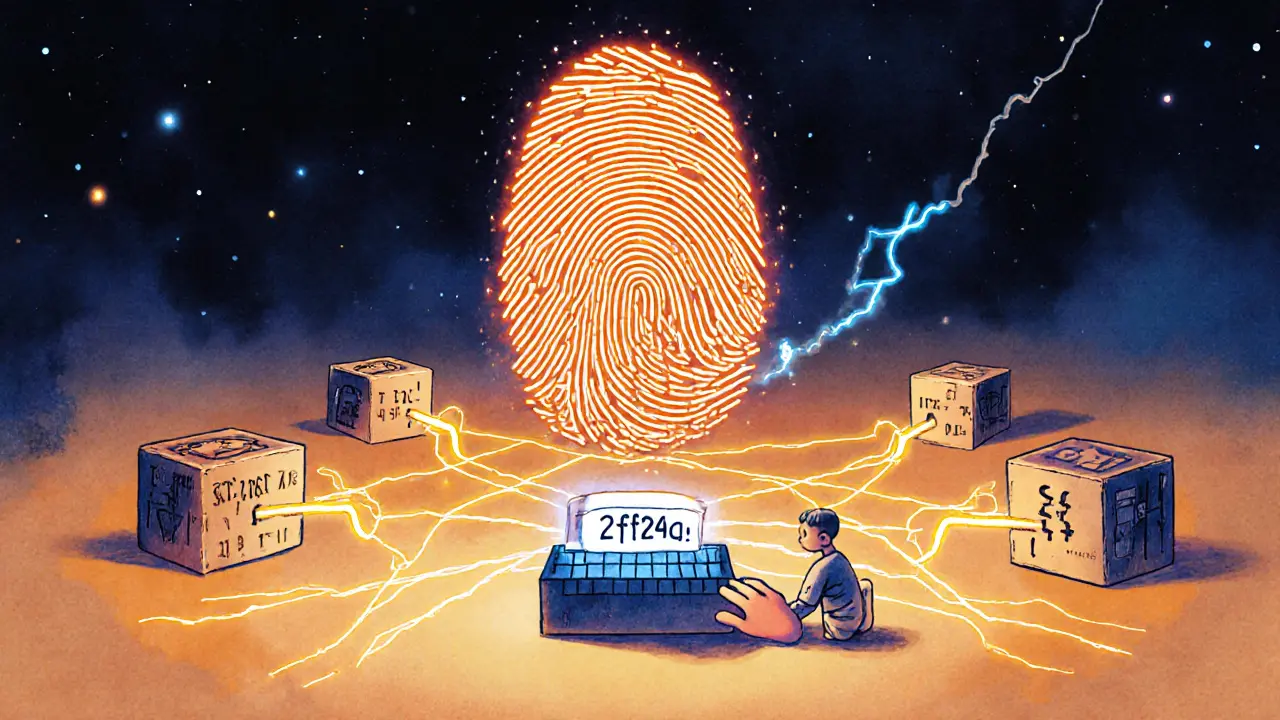Cryptographic Hash Demonstrator
Enter text to see how cryptographic hashing transforms data. Try changing just one character to see the avalanche effect in action.
Imagine a digital ledger that can’t be changed-not because someone is watching, but because math makes it impossible. That’s the power of cryptographic hashing in blockchain. It’s not magic. It’s not encryption. It’s a one-way mathematical process that turns any piece of data-whether it’s a single word or a million transactions-into a fixed-length string of letters and numbers. And once it’s done, there’s no going back.
Every block in a blockchain holds a hash of its own data, plus the hash of the block before it. Change one letter in one transaction? The entire chain breaks. The hash changes. Every block after it becomes invalid. That’s how blockchain stays tamper-proof. No central authority needed. Just math.
How Cryptographic Hashing Works in Simple Terms
Think of a hash like a fingerprint for data. You feed in any input-your name, a bank transfer, a photo-and out comes a unique string, usually 64 characters long for SHA-256. It doesn’t matter if your input is 10 bytes or 10 gigabytes. The output is always the same size.
Here’s a real example. Type echo -n 'hello' | openssl sha256 into a terminal and you’ll get:
2cf24dba5fb0a30e26e83b2ac5b9e29e1b161e5c1fa7425e73043362938b9824
Now change it to hello!-just add an exclamation point. The hash becomes:
921c3165240575793100732800417542715359707939835301314822e3654a9f
Notice how almost every character changed? That’s the avalanche effect. One tiny tweak, massive output shift. That’s intentional. It makes it impossible to guess what input created a hash just by looking at the output.
The Eight Rules That Make Hashing Secure
Not all hash functions are built the same. Cryptographic hashing follows strict rules to work in blockchain. Here are the eight that matter:
- Deterministic: Same input, always same output. No randomness.
- Fast computation: A modern ASIC miner calculates SHA-256 in 0.0002 seconds. Speed matters when you’re processing thousands of transactions per second.
- Avalanche effect: Change one bit? Half the output flips. Makes pattern detection useless.
- Fixed output size: SHA-256 always gives 256 bits (64 hex characters). No exceptions.
- Preimage resistance: You can’t reverse-engineer the input from the hash. Try it. Take that 64-character string and guess what created it. Impossible.
- Second preimage resistance: Given an input, you can’t find another input that produces the same hash.
- Collision resistance: It’s computationally infeasible to find two different inputs that create the same hash. You’d need to try 2^256 combinations. That’s more than the number of atoms in the observable universe.
- Puzzle friendliness: Even if you know part of the input, you can’t predict the output. This is why miners can’t cheat-they have to brute-force nonces until they find the right hash.
These aren’t theoretical. They’re why Bitcoin has never been hacked at the hashing level-even after 14+ years and $500 billion in market value.
SHA-256, SHA-3, and BLAKE2: The Big Three
Not all blockchains use the same hash function. The choice affects speed, security, and energy use.
| Hash Function | Used By | Output Size | Speed (Software) | Energy Use | Quantum Resistance |
|---|---|---|---|---|---|
| SHA-256 | Bitcoin, Litecoin | 256 bits | Fast (optimized for ASICs) | High (30B hashes/joule) | Vulnerable |
| SHA-3 (Keccak) | Ethereum | 224/256/384/512 bits | 15-20% slower | Medium | Stronger |
| BLAKE2b | Nano, Polkadot | 512 bits | 1.3-1.7x faster than SHA-256 | Low | Good |
Bitcoin sticks with SHA-256 because it’s proven. The network has processed over 10^21 hashes since 2009 without a single collision. But it’s energy-heavy. That’s why Ethereum switched to SHA-3 after moving to proof-of-stake-it’s more efficient for software-based verification.
BLAKE2b is the dark horse. It’s faster, uses less power, and still meets all cryptographic standards. That’s why newer chains like Polkadot and Nano use it. It’s the future for lightweight blockchains.

How Hashing Builds the Chain: Blocks and Merkle Trees
Each block in a blockchain has three key parts:
- A list of transactions
- A timestamp
- The hash of the previous block
The hash of the previous block is what links everything together. If someone tries to change a transaction in Block 100, the hash of Block 100 changes. That breaks Block 101’s link, which breaks Block 102, and so on. To fake a change, you’d need to redo every block after it-faster than the network adds new ones. That’s why blockchain is immutable.
But storing every transaction in every block would be slow. That’s where Merkle trees come in. Instead of hashing each transaction individually and storing them all, the system groups transactions into pairs, hashes them, then hashes those hashes together, until it ends with one single hash: the Merkle root.
This lets a wallet verify a transaction without downloading the whole block. You only need the Merkle root and a few hashes along the path-just 32 bytes instead of 1MB+. That’s how lightweight wallets like Electrum work on your phone.
Real-World Problems Developers Face
Hashing sounds simple. Until you try to code it.
One common issue? Endianness. That’s the order bytes are stored in memory. Bitcoin uses little-endian. Many programming languages default to big-endian. A developer in Tokyo wrote a node that worked fine-until it connected to a server in Germany. The hashes didn’t match. Took 72 hours to debug.
Another problem: nonce exhaustion. Miners change a number (the nonce) over and over until the hash starts with enough zeros. On Bitcoin, you need to try about 4 billion times on average. If your hardware can’t keep up, you miss blocks.
And then there’s the risk of timestamp manipulation. In one case (GitHub issue #2847), a network split caused a block to use an old timestamp. The hash calculation failed because the algorithm expected a certain sequence. It was fixed, but it shows how fragile the system can be under edge conditions.
Most beginners mess up hexadecimal vs. binary conversion. A hash is a string of hex characters-but internally, it’s binary. Mixing them up causes 28% of early errors, according to CryptoZombies.io.

Why It Matters Beyond Bitcoin
Cryptographic hashing isn’t just for money. It’s the backbone of trust in digital systems.
Supply chains use it to track goods. A drug’s journey from factory to pharmacy? Each step is hashed and chained. If someone tampers with the label, the hash breaks. Hospitals use it to verify patient records. Governments use it for land registries.
The EU’s MiCA regulation, effective in 2024, requires all compliant crypto assets to use cryptographic hashing that meets NIST FIPS 180-4 standards. That’s not a suggestion. It’s law.
Even companies like Walmart and Maersk use blockchain hashing to track food shipments. If a batch of spinach is contaminated, they trace it back in seconds-not days.
What’s Next? Quantum Threats and Post-Quantum Hashing
Here’s the big worry: quantum computers.
Current hash functions like SHA-256 rely on math that’s hard for classical computers. But quantum computers can run algorithms like Grover’s to search through possibilities much faster. Experts estimate a quantum computer with 1,500+ qubits could break SHA-256. We don’t have one yet-but Google’s 70-qubit chip in 2023 showed progress.
NIST is already working on post-quantum standards. One candidate? SPHINCS+, a hash-based signature scheme designed to survive quantum attacks. Bitcoin is testing it in BIP 342 (still draft). Ethereum’s Verkle trees, launching in 2024-2025, will replace Merkle trees with even more efficient hash structures.
The good news? We’re not waiting for a disaster. The industry is preparing. Hybrid systems-mixing classical hashing with quantum-resistant algorithms-will likely be the norm by 2030.
How to Get Started
Want to see hashing in action? Here’s how:
- Install OpenSSL:
brew install openssl(Mac) or download from openssl.org - Run:
echo -n 'test' | openssl sha256 - Try changing the input. Watch how the hash changes.
- Use Python:
import hashlib; print(hashlib.sha256(b'test').hexdigest())
For deeper learning, read the Bitcoin Developer Guide or Ethereum’s Yellow Paper. Stack Exchange has over 23,000 hashing questions with 90%+ answer rates. You’re not alone if you get stuck.
It takes 40-60 hours to become comfortable with hashing in practice. But once you understand it, you see blockchain for what it really is: not a ledger. A mathematical guarantee.

Hashing is just math doing the heavy lifting so we don’t have to trust people
This is one of those things that sounds like wizardry until you actually play with it in a terminal. I typed 'hello' and 'hello!' and just stared at the screen like... wow. That’s insane. It’s not magic, but it feels like it. I’ve shown this to my niece who’s 12 and she got it instantly. That’s the power of clean explanation.
Of course you’re gonna love SHA-256. It’s the Bitcoin cult’s favorite toy. Meanwhile, real systems use BLAKE3 now because it’s 3x faster and doesn’t waste enough electricity to power a small country. You’re still stuck in 2009. Get over it.
What’s fascinating isn’t just that hashing makes tampering impossible-it’s that it turns trust into a mechanical certainty. We used to need banks, notaries, governments to verify. Now we just need a hash function that doesn’t break. It’s a quiet revolution. No one’s waving flags, no one’s giving speeches. Just code doing what math promised it could. We’re living in the age of algorithmic faith.
And yet... we still panic when our wallet app glitches. We still beg for ‘customer support’ like we’re back in 2010. The tech is mature. The human mind? Not so much.
Thanks for breaking this down so clearly. I’ve been trying to understand Merkle trees for weeks and this finally clicked. I’m gonna try the Python example tonight. No emojis, just gratitude 😊
BLAKE2b? That’s some crypto bro nonsense. SHA-256 is the only real standard. Anyone using anything else is either a startup trying to look cool or a Chinese state-backed project. The EU’s MiCA? Good. At least someone’s enforcing real crypto rules. Not this hippie ‘decentralized everything’ crap.
Endianness issues are the silent killers of blockchain dev teams. I once spent three days on a node sync issue because someone used Python’s default byte order and didn’t flip it. The hash mismatch was subtle-just one bit off in 256. Took a hex dump and a debugger to find it. Classic.
Also, nonce exhaustion is real. My old ASIC miner would stall for hours on blocks with high difficulty. You start questioning your life choices.
So... you’re telling me the entire security of Bitcoin relies on not mixing up hex and binary? That’s it? That’s the foundation of $500 billion? I mean... I get it. But also... wow. That’s like building a vault out of duct tape and hoping no one notices the seam. 😅
i tried the openssl thing but i typed echo -n 'hello' | openssl sha256 and it said command not found… do i need to install something? lol
Wait, so if I change one letter in a 10GB file, the whole hash changes completely? That’s wild. So like… if I edited one pixel in a 4K photo, the hash would be totally different? That’s insane. I’m gonna try this on my cat photo right now. BRB.
It’s funny how we treat hashing like a sacred ritual. We worship its determinism, its avalanche effect, its collision resistance… but we forget it’s just a function. A very well-designed one, sure. But still, it’s code. It doesn’t care about justice, or truth, or fairness. It just maps inputs to outputs. The real magic is how we’ve built trust on top of something so cold and mechanical.
Quantum computers will break this. Done. Next.
OMG this is SO helpful!! 💖 I just learned what a Merkle tree is and now I feel like a crypto genius!! 🤓 I used the Python code and it worked on the first try!! 🎉 I’m gonna share this with my book club!! 📚✨
Everyone’s acting like hashing is the answer to everything… but what if the math is wrong? What if someone figured out a way to reverse SHA-256 and no one knows? What if this whole system is just a beautiful lie? What if we’re all just… trusting a black box because we’re too scared to ask the real questions?
BLAKE2b is faster? Big deal. SHA-256 is proven. Everyone else is just trying to reinvent the wheel because they don’t understand the basics. If you can’t handle SHA-256 you shouldn’t be coding blockchain. End of story.